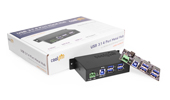If you’ve been out shopping sometime in the past few years, you’ve no doubt noticed that self-service kiosks are becoming more and more popular in all kinds of stores. They’ve even debuted in the fast-food industry, allowing patrons at McDonald’s, Taco Bell, and others to place their orders without once needing to speak to someone at a register. While there have been varying opinions regarding this technology and its application, an important trend has emerged according to Forbes.
According to recent numbers, over 65 percent of people said they would be more likely to visit a restaurant if it offered a self-service kiosk for placing their order. Given that roughly a year ago the numbers indicated that 78 percent of people would be less likely to visit a restaurant that offered a kiosk, that’s a rather impressive turnaround.
Younger Demographics, and Screen Familiarity
One of the points recognized by Forbes is that the adoption of self-service kiosks in restaurants in particular, and in the retail industry in general, is that the younger generations of consumers are the ones who are taking up more room in the markets. Millennials and Gen Z grew up with technology in their hands, and generally speaking, they’re far more comfortable using a digital ordering space than Baby Boomers are; an advantage when one considers those younger consumers are becoming the bigger target demographic for companies the world over.
That generational shift can be thought of as the proverbial rock tossed into a pond; it was the point of impact, but the ripples of change are still spreading out from it. With these kiosks becoming more common, they’re also becoming more functional, and more affordable for smaller businesses to adopt. While they haven’t supplanted more traditional cashiers and check-out lanes, they are going through a similar transformation to what credit cards once did. Which is to say a new technology that was first only used by a small number of people, but which quickly grew to become the standard for how business is conducted.
Kiosks Make More Sales
While these kiosks make checkout faster and easier for customers in many cases (particularly those who don’t have the social energy to engage with a flesh-and-blood cashier at that particular moment), they also provide a sales advantage for businesses who use them according to Storis. These computerized stations can offer customers a full range of current coupons and deals, in addition to making last-minute add-on suggestions that a customer might not have thought about. The digital equivalent of, “Would you like fries with that?” A strategy that’s remained popular in retail because even if only one in every ten customers says yes, that’s a lot of additional fries sales by the end of the business day.
The other, major advantage of these self-service kiosks is that they take the pressure off of other sales associates. If there’s a long line, it’s possible for someone to just check themselves out. Or, alternatively, an associate can continue on with the task they were in the middle of (stocking, altering signing, clean up, etc.) instead of shifting to checking customers out at the register in stores where associates have to handle all the duties on their own. When you combine those advantages with the upswing in popularity these devices have experienced recently, it should come as absolutely no surprise that they’re cropping up all over the retail landscape.
For more information on the latest information about self-service kiosks, as well as the changes and latest technologies being integrated into these retail solutions, all you have to do is contact us today!



















